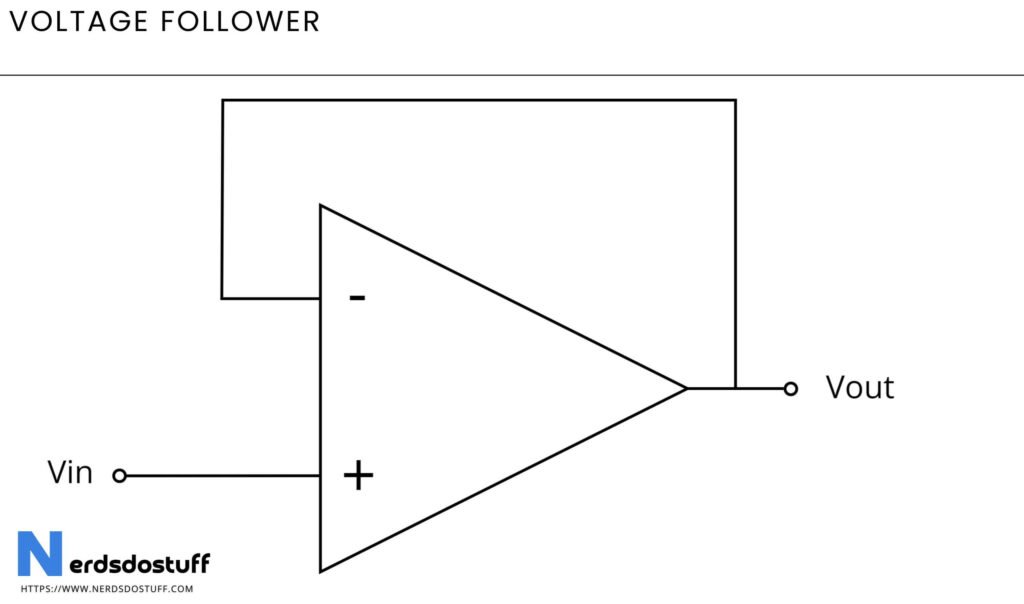What is Voltage Follower ?
A voltage follower, also known as a unity gain amplifier, is a configuration of an operational amplifier (op-amp) where the output voltage directly follows the input voltage. In this circuit, the input signal is connected to the non-inverting input terminal (+) of the op-amp, while the output is fed back to the inverting input terminal (-). Since the op-amp strives to keep the voltages at its input terminals equal, the output voltage mimics the input voltage with a negligible voltage drop. Essentially, the voltage follower acts as a buffer, providing high input impedance and low output impedance, which allows it to isolate the input source from the load while maintaining the same voltage level. This configuration finds applications in impedance matching, signal buffering, and driving capacitive loads where voltage amplification is not required but signal integrity and isolation are essential.
Voltage Follower Circuit

Working of Voltage Follower
The voltage follower operates by utilizing an operational amplifier to replicate the input voltage at its output while maintaining a gain of 1. When an input voltage is applied to the non-inverting input of the op-amp, it compares this voltage with the voltage at its inverting input, which is connected directly to the output. The op-amp adjusts its output voltage to match the input voltage, effectively “following” it. This happens due to the high open-loop gain of the op-amp, which forces the voltage at the inverting input to be nearly equal to that of the non-inverting input. Consequently, the output voltage closely tracks the input voltage. The main function of the voltage follower is to provide impedance matching and isolation between circuits, ensuring minimal signal distortion and allowing for efficient signal transmission between different stages of a circuit.
Characteristics of Voltage Follower
| Characteristic | Description |
|---|---|
| Gain | Unity gain (gain of 1), meaning the output voltage follows the input voltage precisely. |
| Input Impedance | Very high input impedance, typically in the order of megaohms, ensuring minimal loading of the input signal source. |
| Output Impedance | Low output impedance, allowing the voltage follower to drive low impedance loads effectively. |
| Voltage Tracking | The output voltage closely tracks the input voltage, minimizing distortion and signal loss. |
| Signal Isolation | Provides isolation between input and output circuits, preventing interaction between them. |
| Application | Commonly used as a buffer between different stages of a circuit, impedance matching, and isolating signal sources. |
Applications of Voltage Follower
- Impedance Matching: Voltage followers are frequently used to match the impedance between two different stages of a circuit. They ensure that the output impedance of one stage closely matches the input impedance of the next stage, optimizing signal transfer and minimizing reflections.
- Buffering: Voltage followers act as buffers between circuits with different impedance levels. They prevent loading effects, ensuring that the source circuit can drive the load circuit efficiently without signal degradation.
- Isolation: In some cases, voltage followers are employed to isolate one part of a circuit from another. By providing a high input impedance and low output impedance, they create a barrier that prevents unwanted interaction between circuits while allowing signal transmission.
- Signal Conditioning: Voltage followers are used in signal conditioning applications where the original signal needs to be preserved while driving subsequent circuitry. They maintain the integrity of the signal by closely replicating it at the output.
- Instrumentation Amplifiers: In instrumentation applications, voltage followers can serve as the input stage of an instrumentation amplifier. They help in maintaining high input impedance and low output impedance while preserving signal fidelity.
- Active Filters: Voltage followers are often integrated into active filter circuits to provide buffering between filter stages. This ensures that the filter response remains stable and that the filter’s characteristics are not affected by loading effects.




